Ah, the joys of pet ownership! We share our homes, our hearts, and yes, sometimes even our beds with these four-legged family members. But being a pet parent isn’t just about the wagging tails and puppy kisses; it’s also about ensuring our furry friends are in the best of health. When your veterinarian prescribes a medication like Tylosin for your dog, you naturally have a ton of questions. Is it safe? How do you administer it? And, of course, are there any alternatives? As a responsible dog owner, you’re in the right place to find out. This blog will unravel the mystery behind Tylosin, its uses, dosages, side effects, and more. Whether you’re a seasoned dog owner or a newbie just starting out, consider this your comprehensive guide to Tylosin for dogs. So, fetch a comfy seat (treats optional!), and let’s dive into everything you need to know. 🐶🐾

What is Tylosin?
Tylosin is an antibiotic that belongs to the macrolide class. Its primary use is to treat infections caused by certain bacteria. Originally developed for use in livestock and poultry, it has since gained popularity in the treatment of certain conditions in small animals, including our beloved dogs.
Here’s a more in-depth look:
- Historical Background: Introduced in the 1960s, Tylosin primarily served in veterinary medicine to treat bacterial infections in a wide range of animals. Its effectiveness against a variety of bacterial strains made it a favorite among livestock farmers.
- Main Components and Active Ingredients: The active ingredient, Tylosin Tartrate, is the component that fights against bacterial infections. It acts by inhibiting protein synthesis in bacteria, making it harder for them to grow and multiply.
- Uses in Dogs: Over time, veterinarians began to recognize the benefits of Tylosin for dogs, particularly in treating certain gastrointestinal conditions. One of the most common uses in dogs is for the treatment of chronic diarrhea, especially when caused by certain bacterial strains or inflammations like colitis.
- Other Applications: While its primary use is antibacterial, Tylosin also has anti-inflammatory properties which can be beneficial in treating some inflammatory conditions in dogs.
Note that while Tylosin can work incredibly well, you should always use it under a veterinarian’s guidance. Like all antibiotics, you must ensure it fits your dog’s specific condition and use it responsibly to prevent antibiotic resistance.
In the following sections, we’ll delve into the specifics of how Tylosin works, how to administer it, and the important considerations every pet owner should be aware of before starting their dog on this medication.
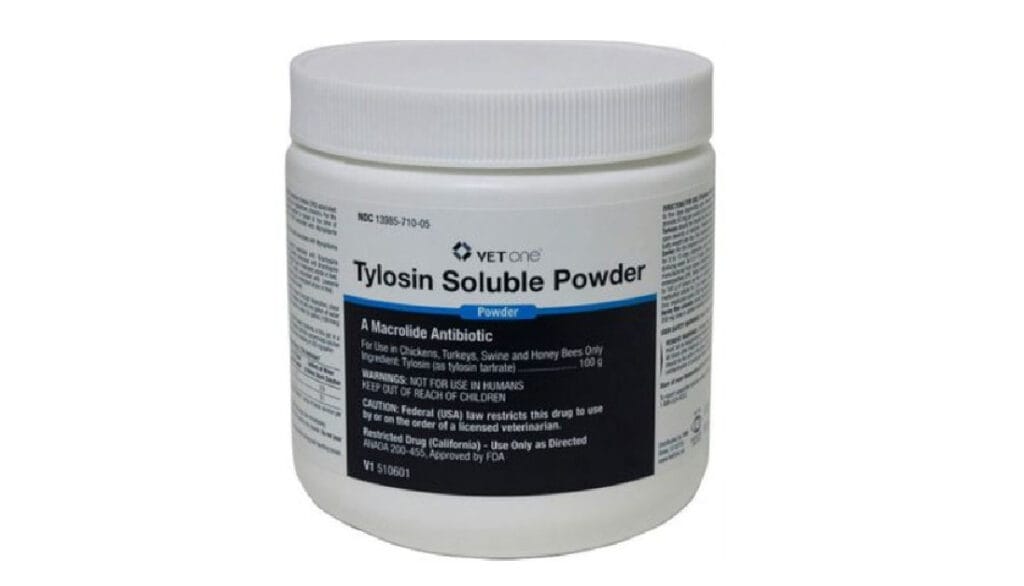
How Does Tylosin Work?
At its core, Tylosin is a warrior against bacteria, but how does it manage to keep these microscopic invaders at bay? To truly understand Tylosin’s effectiveness, we need to delve a bit into the cellular level and its interaction with bacteria.
- Targeting Protein Synthesis: Tylosin works by inhibiting protein synthesis in bacteria. Every bacterium needs to produce proteins to function, grow, and replicate. By interfering with this vital process, Tylosin effectively stalls the bacteria’s lifecycle, making it unable to multiply and spread.
- Bacteriostatic vs. Bactericidal: While some antibiotics are bactericidal (they kill bacteria directly), Tylosin is primarily bacteriostatic. This means it doesn’t necessarily kill the bacteria but prevents them from growing and multiplying. This halt in bacterial growth allows the dog’s immune system to catch up and eliminate the invaders.
- Specificity to Gram-positive Bacteria: Tylosin effectively combats a range of Gram-positive bacteria, which have a specific type of cell wall structure. This includes bacteria like Staphylococcus, Streptococcus, and certain Mycoplasma species. It’s also effective against some Gram-negative bacteria, though its primary strength lies with the Gram-positive ones.
- Anti-inflammatory Properties: Beyond its antibacterial prowess, Tylosin has demonstrated anti-inflammatory effects. For dogs with conditions like colitis—an inflammation of the inner lining of the colon—this dual action can provide substantial relief. By reducing inflammation and tackling bacterial culprits, Tylosin can restore a sense of balance to the dog’s gastrointestinal tract.
Understanding the ‘how’ behind Tylosin is crucial, especially when considering its use for our canine companions. It’s not just about eliminating bacteria; it’s about creating an environment where our dogs’ own defenses can flourish and help restore them to their playful, tail-wagging selves. Always consult with a veterinarian to ensure Tylosin is the right choice for your pup’s specific needs.
How is Tylosin Administered?
Administering medication to our furry friends can sometimes feel like a daunting task. With Tylosin, the good news is that there are multiple forms and methods to choose from, ensuring that both you and your dog have the smoothest experience possible. Here’s a breakdown:
Oral Administration:
- Capsules/Pills: Vets often provide Tylosin in capsule or pill form. Depending on your dog’s size and the prescription, they might instruct you to administer a full or partial pill. You can hide these in treats, mix with food, or give them directly.
- Powder: Some vets like to prescribe Tylosin in a powder that you can blend into your dog’s meals. This option works well if you need dosage flexibility or if your dog dislikes pills.
- Liquid (Soluble): Some manufacturers offer soluble Tylosin versions, which you can mix with water or food, though they’re less common.
Intramuscular Injection:
In specific cases or conditions, a veterinarian might administer Tylosin via an intramuscular injection. Clinicians often use this method in clinical settings, although it’s less common for routine at-home treatments.
Considerations for Giving Tylosin:
- With Food: Tylosin is typically well-tolerated when given with food. This can also help reduce the chances of stomach upset.
- Consistency: It’s essential to administer the antibiotic at consistent times each day to maintain steady levels in the dog’s system.
- Complete the Course: Just like with human antibiotics, it’s vital to ensure your dog completes the entire prescribed course of Tylosin, even if symptoms improve. This helps prevent antibiotic resistance.
Storage:
- Powder and Pills: Store these in a cool, dry place, away from direct sunlight.
- Liquid: If you’re using a soluble form, it may require refrigeration. Always check the label or consult with your vet about proper storage.
Monitoring:
- Watch for Allergies: Though rare, dogs can be allergic to medications, including Tylosin. Symptoms might include hives, difficulty breathing, or swelling. Contact your vet immediately if you suspect an allergic reaction.
- Appetite and Behavior: Monitor your dog’s appetite and behavior. If you notice a significant change or any signs of illness, consult your vet.
Remember, while Tylosin is generally safe and effective, it’s not a one-size-fits-all solution. Your vet will provide guidance tailored to your dog’s specific needs, ensuring the best possible outcome. As always, when in doubt, reach out to a professional. Your dog’s health and comfort are worth that extra bit of care!
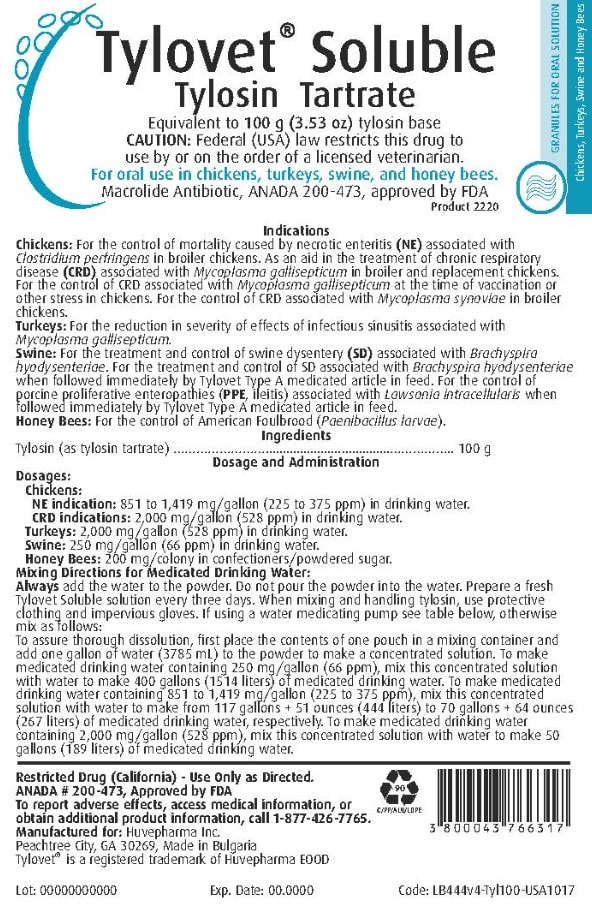
Is Tylosin Safe for Dogs?
As with any medication, the first question we often ask ourselves is, “Is this safe for my furry friend?” Tylosin, when used correctly and under veterinary supervision, is generally safe for dogs. However, like all drugs, there are nuances to consider and precautions to take.
Safety Profile:
- FDA Approval: The FDA approves Tylosin for use in certain livestock animals, but it’s important to note that its use in dogs is “off-label.” This means the FDA hasn’t specifically approved it for dogs.
- However, veterinarians often prescribe medications off-label when they believe the benefits outweigh potential risks based on their medical expertise.
- Common Usage: Vets have used Tylosin for years in veterinary medicine for dogs despite its off-label status, and many are familiar with its safety profile and potential side effects.
Potential Concerns:
- Overuse & Antibiotic Resistance: Like all antibiotics, the overuse or misuse of Tylosin can contribute to antibiotic resistance. This is when bacteria evolve and become immune to the antibiotic’s effects. It’s crucial to administer the drug as prescribed and complete the full course, even if your dog seems better.
- Liver Function: If a dog has liver problems or a history of liver disease, it’s essential to discuss this with your vet.
- The liver metabolizes Tylosin, so dogs with liver concerns might require regular monitoring.
- Drug Interactions: Tylosin may interact with other medications, so always inform your vet of any other drugs, supplements, or treatments your dog is receiving.
- Puppies & Senior Dogs: Age can play a role in how a dog reacts to medication. Puppies, with their developing systems, and senior dogs, with potential age-related health issues, might have different responses to Tylosin. Always consult with your vet about age-specific concerns.
- Pregnant or Lactating Dogs: If your dog is pregnant or nursing, it’s crucial to discuss with your vet before administering Tylosin.
While Tylosin is generally safe for many dogs, individual circumstances and health profiles can vary. The key to ensuring the safety and effectiveness of Tylosin—or any medication—is open communication with your vet and careful observation of your dog while they’re on the treatment. By staying informed and vigilant, you can ensure your pup gets the benefits of the medication while minimizing potential risks.
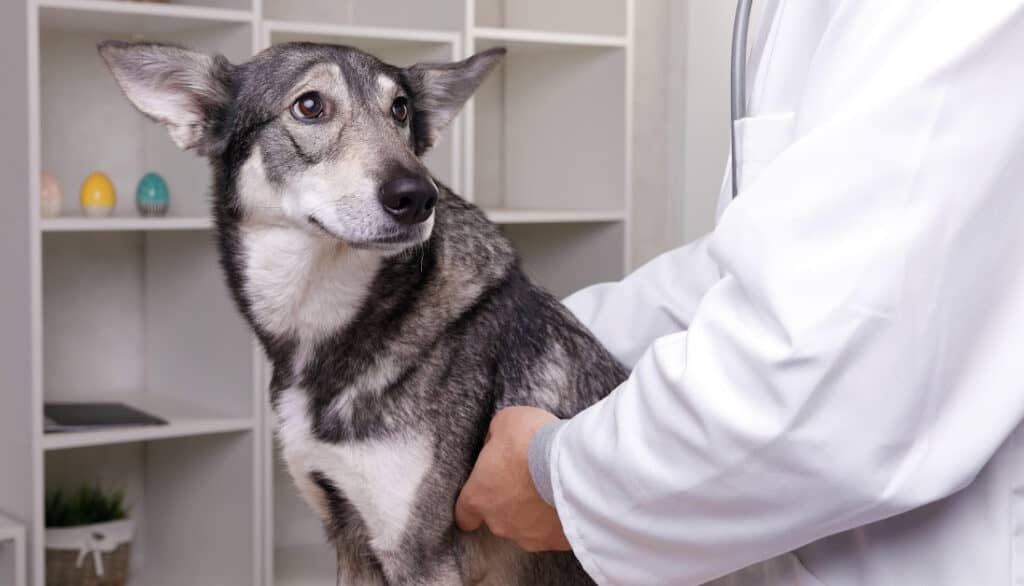
Tylosin Side Effects or Cautions
Every medication, no matter how commonly used or well-tolerated, carries the potential for side effects. While Tylosin is generally safe for dogs, it’s essential for pet owners to be aware of possible side effects and exercise necessary precautions. Here’s a comprehensive look:
1. Potential Side Effects of Tylosin:
- Digestive Issues: The most common side effects are gastrointestinal in nature. Some dogs might experience:
- Diarrhea or loose stools
- Vomiting or nausea
- Decreased appetite
- Allergic Reactions: Though rare, dogs can develop an allergic reaction to Tylosin. Symptoms to watch out for include:
- Swelling, particularly of the face, lips, or tongue
- Hives or skin rashes
- Difficulty breathing or rapid breathing
- Sudden onset of itchiness
- Yeast Overgrowth: Long-term use can occasionally lead to yeast overgrowth in the intestines, which might require additional treatment.
2. Cautions When Using Tylosin:
- Administer As Prescribed: Always give the prescribed dosage and follow your veterinarian’s instructions closely. Overdosing can exacerbate side effects or lead to other health concerns.
- Avoid Abrupt Withdrawal: Don’t suddenly stop giving Tylosin without consulting your veterinarian, especially if it’s been a long-term treatment.
- Interactions with Other Drugs: Tylosin can interact with other medications. Always inform your vet about any other drugs your dog might be taking, including over-the-counter meds, supplements, and herbal remedies.
- Monitoring During Treatment: Especially if your dog is on Tylosin for an extended period, regular vet check-ups can help monitor liver function and ensure the medication remains appropriate for your dog’s condition.
- Use in Specific Populations: If your dog is very young, elderly, pregnant, lactating, or has pre-existing health conditions, a discussion with your veterinarian before starting Tylosin is paramount.
- Antibiotic Resistance: Using antibiotics inappropriately can contribute to antibiotic resistance, where bacteria become immune to the drug’s effects. This is a growing global health concern. Ensure you use Tylosin responsibly and as directed.
3. What to Do If You Observe Tylosin Side Effects:
- Immediate Action: If you notice severe reactions, especially symptoms of an allergic reaction like swelling or difficulty breathing, seek veterinary care immediately.
- Milder Symptoms: For less urgent side effects, such as mild diarrhea or a slight decrease in appetite, make a note of the symptoms and discuss with your vet at the earliest opportunity. They might adjust the dosage or suggest other supportive care.
- Record Keeping: Keeping a diary or log of any observed side effects can be helpful. This not only provides your vet with a clear picture but can also help in tailoring the best treatment plan moving forward.
In conclusion, while Tylosin has proven to be a beneficial drug for many dogs, vigilance on the part of the pet owner is crucial. By being observant and maintaining open communication with your veterinarian, you can ensure your dog benefits from the treatment while minimizing potential adverse effects.
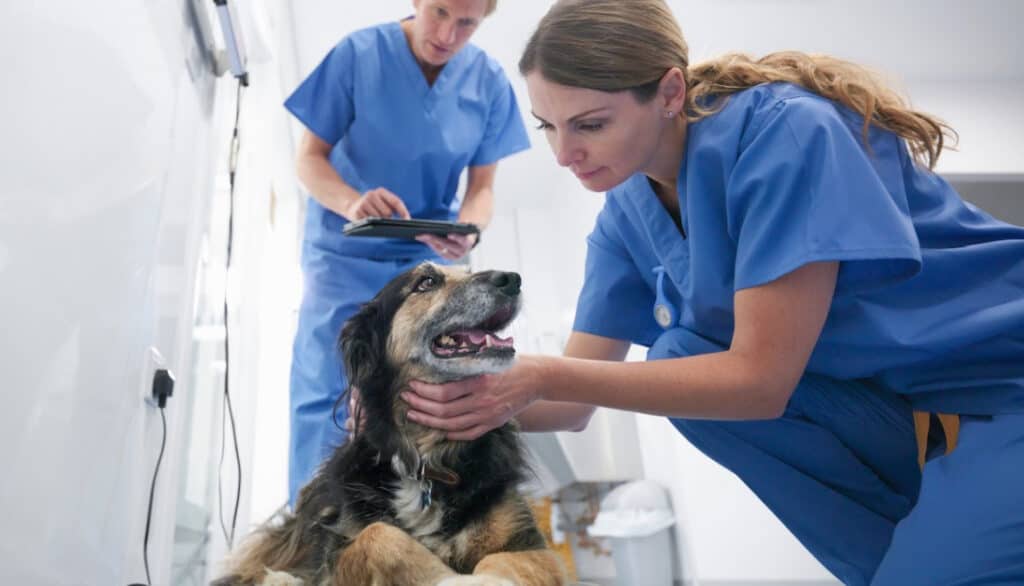
Uses of Tylosin for Dogs
Tylosin has been a staple in veterinary medicine for several decades. While it originated in the livestock sector, its efficacy and safety profile soon caught the attention of small animal veterinarians. In dogs, Tylosin has several key uses:
1. Chronic Diarrhea and Gastrointestinal Issues:
- Colitis: Veterinarians commonly prescribe Tylosin for dogs to treat colitis, an inflammation of the colon. Its anti-inflammatory and antibiotic properties soothe the gut lining and tackle bacterial imbalances contributing to the problem.
- Antibiotic-Responsive Diarrhea (ARD): Some dogs experience persistent diarrhea that responds well to antibiotic treatment, even without identifying a specific bacterial cause. In these situations, veterinarians often choose Tylosin for its proven effectiveness.
2. Bacterial Infections:
- Specific Infections Treatment: Tylosin effectively treats certain Gram-positive bacteria, such as Staphylococcus, Streptococcus, and some Mycoplasma species. Veterinarians use it to treat infections these bacteria cause in different parts of the body.
- Prevention: In certain situations, especially in kennels or shelters, veterinarians might use Tylosin prophylactically to prevent bacterial infections, especially during outbreaks or when risks are high.
3. Respiratory Issues:
- Mycoplasma Infections: Tylosin is effective against certain Mycoplasma species, which can cause respiratory issues in dogs. Doctors can prescribe it to treat coughs or other respiratory symptoms that result from this type of infection.
4. Soft Tissue Infections:
- Skin and Ear Infections: When bacteria susceptible to Tylosin cause infections of the skin or ears, you can use this antibiotic to treat them.
Caveats:
- Always Under Supervision: Always administer Tylosin under the supervision and guidance of a veterinarian, despite its multiple uses and benefits. It’s essential to ensure it’s the right treatment for the dog’s specific condition.
- Short-term vs. Long-term: Some conditions might require short-term use of Tylosin, while others, like chronic gastrointestinal issues, might see the drug prescribed for longer durations. Regular vet check-ups are crucial, especially for long-term use, to monitor any potential side effects or changes in the dog’s condition.
Tylosin is a versatile medication with various applications in canine health. Its longstanding history in veterinary medicine attests to its efficacy, but as always, individualized veterinary advice is paramount to ensure a dog’s health and well-being.

Tylosin Dosage Chart for Dogs
When it comes to administering Tylosin or any medication to dogs, getting the correct dosage is crucial for effectiveness and safety. Below, we’ll provide general guidelines, an age and weight-based dosage chart, and tips for ensuring accurate dosing.
General Dosage Guidelines:
- The typical dosage range for Tylosin in dogs is around 5-20 mg/kg once to twice daily.
- The specific condition being treated determines the exact dosage and duration.
- Always administer the exact dose prescribed by the veterinarian and follow their instructions closely.
Age and Weight-Based Dosage Chart:
| Weight Range | Puppies (Up to 6 Months) | Adult Dogs (6 Months & Older) | Senior Dogs (8 Years & Older) |
|---|---|---|---|
| Up to 10 lbs | 5 mg | 5-10 mg | 5 mg |
| 10-20 lbs | 10 mg | 10-20 mg | 10 mg |
| 20-40 lbs | 20 mg | 20-40 mg | 20 mg |
| 40-60 lbs | 30 mg | 40-60 mg | 40 mg |
| 60-80 lbs | 40 mg | 60-80 mg | 60 mg |
| Over 80 lbs | 50 mg | 80-100 mg (max) | 80 mg |
Note: This table provides general dosage guidelines based on weight and age. However, individual needs can vary, so always consult with your veterinarian for the exact dosage.
Tips for Ensuring Accurate Tylosin Dosing:
- Use a Dedicated Measuring Tool: If you’re administering liquid or powder form, use a dedicated measuring spoon or syringe provided by your vet or pharmacy. Avoid using household spoons as they can vary in size.
- Consistency is Key: Administer the medication at the same time(s) each day to maintain a consistent level in the dog’s system.
- Monitor for Side Effects: Especially when starting a new medication, observe your dog for any side effects or adverse reactions.
- Avoid Splitting Pills Without Guidance: If your dog requires a dosage that isn’t available in a pre-made pill, consult your vet about splitting the tablet. Some medications can lose effectiveness if broken.
- Store Medication Properly: Store the medication as directed, usually in a cool, dry place, to preserve its potency.
- Check Expiry: Regularly check the expiry date on the medication. Out-of-date medication can lose its effectiveness and may not be safe.
- Double-Check Dosage: Especially if multiple people in a household might administer medication, have a system in place to track doses, so the dog isn’t accidentally given too much.
While the chart provides a general guideline, it’s crucial to reiterate that individual needs can vary. The veterinarian’s prescribed dose should always be the primary guide. Proper dosing ensures the medication’s efficacy and the safety of your furry friend.

Forms of Tylosin
Tylosin is a versatile antibiotic, and to cater to the various needs of animals, including dogs, it’s available in several forms. Each form has its advantages, making it suitable for different scenarios and preferences.
1. Tylosin Powder:
- Overview: This is one of the most common forms of Tylosin, especially for livestock. For dogs, the powder can be mixed with their food, ensuring they consume the entire dose.
- Advantages:
- Allows for easy dose adjustments.
- Can be mixed with wet or dry food.
- Suitable for dogs that resist taking pills.
- Considerations:
- Ensure even mixing to guarantee the dog receives the full dosage.
- Some dogs might be wary if they detect a change in their food.
2. Tylosin Capsules:
- Overview: Tylosin capsules contain the antibiotic in a powdered form, enclosed in a gelatin casing. They can be given directly or opened to mix the inner powder with food.
- Advantages:
- Convenient and quick to administer.
- Capsules can sometimes be easier for dogs to swallow than tablets.
- Dosage is pre-measured, reducing the margin for error.
- Considerations:
- Some dogs might resist swallowing capsules.
- Opening capsules to mix with food might make dosing less precise if not all contents are consumed.
3. Tylosin Liquid (Injectable or Oral Solution):
- Overview: Liquid Tylosin can either be an injectable solution or an oral suspension. The former is administered via injection, usually by a vet, while the latter is given orally.
- Advantages:
- Liquid solutions can be more comfortable for some dogs to consume, especially if mixed with a tasty treat.
- Injectable form ensures that the dog receives the entire dose.
- Considerations:
- The oral solution must be shaken well before use to ensure even distribution of medication.
- Injectable forms can be more invasive and might not be suitable for frequent dosing.
4. Tylosin Tablets:
- Overview: Tylosin tablets are a compact form that contains a pre-measured dose of the antibiotic.
- Advantages:
- Easy to administer for dogs accustomed to taking pills.
- Convenient for travel or on-the-go dosing.
- Considerations:
- Some dogs might resist or spit out tablets.
- Breaking tablets for dose adjustment can sometimes lead to uneven dosages.
Choosing the Right Form of Tylosin:
The ideal form of Tylosin for your dog will depend on various factors:
- Frequency of Dosing: If it’s a one-time or short-term treatment, an injectable solution might be more straightforward. For long-term treatments, oral solutions or powders might be more manageable.
- Dog’s Preferences: Some dogs have no issues with tablets or capsules, while others might prefer a powder mixed in their food.
- Owner’s Convenience: If you’re comfortable giving injections and it’s the recommended form, that might be your choice. Otherwise, oral options might be more practical.
Always consult with your veterinarian about which form of Tylosin is most suitable for your dog’s condition and lifestyle. Regardless of the type, ensuring that your dog receives the correct dose on the recommended schedule is paramount for the medication’s success.

How Long Does Tylosin Last in the System?
The duration Tylosin remains active within a dog’s system can be essential knowledge for pet owners. Understanding this information is vital both for grasping the medication’s effectiveness and for knowing how long any potential side effects might take to subside after discontinuing the drug.
Pharmacokinetics of Tylosin:
- Absorption: After oral administration, Tylosin is rapidly absorbed from the dog’s gastrointestinal tract. Peak plasma concentrations (the highest level of the drug in the bloodstream) typically occur within 1 to 2 hours post-dosing.
- Distribution: Tylosin, being a lipophilic compound, distributes widely throughout the body. This distribution is a reason it’s effective against infections in various parts of the body.
- Metabolism & Elimination: The liver metabolizes Tylosin, and the breakdown products, along with some unchanged Tylosin, are excreted primarily via bile into the feces. A smaller amount is eliminated through the urine.
Duration in the System:
- Half-life: The half-life of a drug indicates the time it takes for the concentration of the drug in the bloodstream to reduce by half. For Tylosin, the half-life in dogs is roughly 1 to 2 hours.
- Complete Elimination: Based on its half-life and general pharmacokinetic principles, Tylosin is expected to be largely eliminated from a dog’s system within 6 to 12 hours. However, trace amounts might remain for up to 24 hours or longer, depending on various factors like the dog’s age, metabolism, liver function, and kidney function.
Considerations:
- Duration of Effectiveness: While Tylosin may be cleared from the system within hours, its therapeutic effects can last longer. This lasting effect is because the drug has already exerted its action on bacteria or the condition being treated.
- Dosing Frequency: Due to its relatively short half-life, Tylosin is often prescribed to be given once to twice daily to maintain therapeutic levels in the dog’s system.
- Drug Interactions: The presence of other medications can sometimes impact how long Tylosin remains in the system. Always inform your veterinarian of any other medications or supplements your dog is taking.
- Age and Health: Older dogs or those with compromised liver or kidney function might process and eliminate medications more slowly than younger or healthier dogs.
While Tylosin is metabolized and excreted relatively quickly, its therapeutic effects are sustained, ensuring that the drug remains effective. As always, pet owners should follow the dosing regimen provided by the veterinarian to maintain optimal therapeutic levels and should consult their vet with any concerns or queries about the medication.

How Long Should Your Dog Take Tylosin?
You should administer Tylosin to a dog for a duration that depends on several factors. These factors are the type of infection or condition you are treating, the dog’s overall health, and the dog’s response to the medication.
General Guidelines:
- Specific Condition: The duration of Tylosin treatment often hinges on the particular condition being addressed:
- For intestinal infections, treatment might last anywhere from a few days to several weeks.
- For chronic conditions like colitis (inflammation of the colon), the treatment could extend for weeks or even months, depending on the severity and response.
- Veterinarian’s Prescription: Always adhere to the recommended treatment duration provided by the vet. If unsure or if there seems to be no improvement, seek clarification rather than discontinuing or extending the medication on your own.
- Completion of Full Course: Even if your dog appears to have recovered, it’s crucial to complete the entire prescribed course of antibiotics, including Tylosin. Discontinuing antibiotics prematurely can result in a resurgence of the infection or lead to antibiotic resistance.
- Regular Check-ups: Especially for prolonged treatments, regular veterinary check-ups are essential. The vet will assess how the dog is responding to the treatment and decide whether to continue, adjust the dose, or switch to another medication.
Factors Influencing Tylosin Treatment Duration:
- Severity of the Condition: Acute infections might require a shorter treatment course, while chronic or severe infections might necessitate a longer period of medication.
- Age and Health of the Dog: Puppies, older dogs, or those with compromised immune systems might require extended treatment durations to ensure complete recovery.
- Potential Side Effects: If your dog experiences significant side effects, your veterinarian might adjust the duration or switch to a different medication.
- Reinfection or Recurrence: Some conditions, especially gastrointestinal ones, can recur. In such cases, your vet might prescribe another course of Tylosin or recommend preventative measures.
Tylosin Cautions and Considerations:
- Monitor for Side Effects: While Tylosin is generally safe, any new or worsening symptoms should be immediately reported to the vet.
- Avoid Overuse: Over-reliance or prolonged use of antibiotics without a valid reason can contribute to antibiotic resistance. Always use Tylosin judiciously, as prescribed.
- Regular Communication: Keeping open communication with your veterinarian ensures that any concerns or observations about your dog’s health are addressed promptly.
The length of time your dog should take Tylosin varies based on individual circumstances. Always follow your veterinarian’s advice, keep an eye out for any changes in your dog’s condition, and never hesitate to seek guidance if unsure about the medication’s duration or effects.
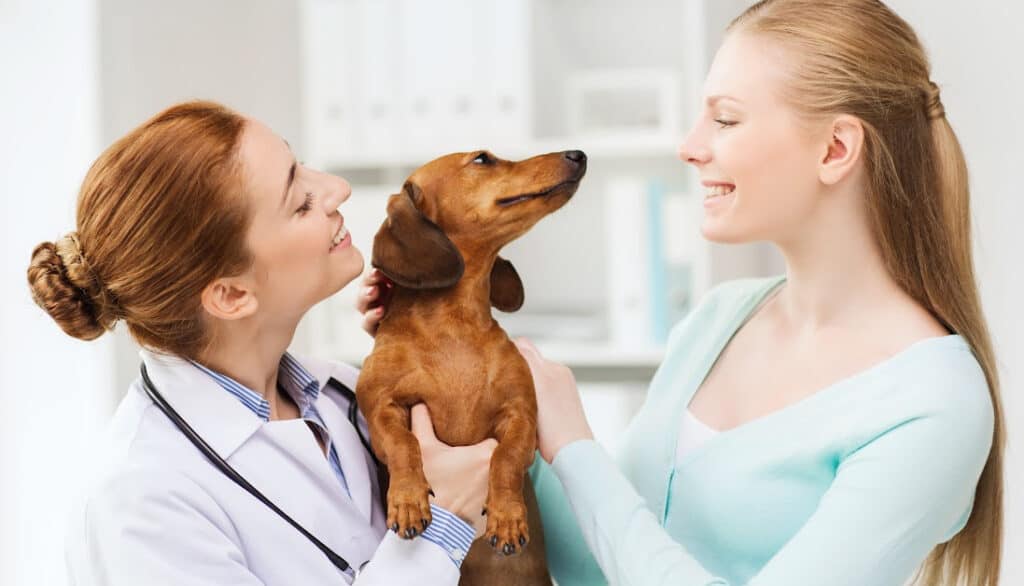
Alternatives To Tylosin
Dr. Candy’s Recommendations:
While Tylosin is effective for various conditions in dogs, there might be situations where an alternative is needed, either due to potential side effects, resistance, or individual dog needs. Dr. Candy, with her vast experience in veterinary care, recommends the following alternatives and complementary treatments to Tylosin:
1. Slippery Elm:
- What it is: Slippery Elm, a tree native to North America, offers its inner bark for medicinal preparations.
- Uses: Slippery Elm soothes and coats the digestive tract, benefiting conditions such as diarrhea, colitis, and stomach and intestine inflammation.
- Advantages: As a natural remedy, Slippery Elm typically produces fewer side effects than synthetic drugs. It treats the stomach gently and works well with other treatments.
2. Homeopet Digestive:
- What it is: HomeoPet Digestive is a homeopathic remedy designed to alleviate digestive issues in pets.
- Uses: It can treat various gastrointestinal symptoms like diarrhea, gas, vomiting, and constipation.
- Advantages: As a homeopathic solution, it’s typically gentle on pets, non-addictive, and can work alongside other treatments without interference.
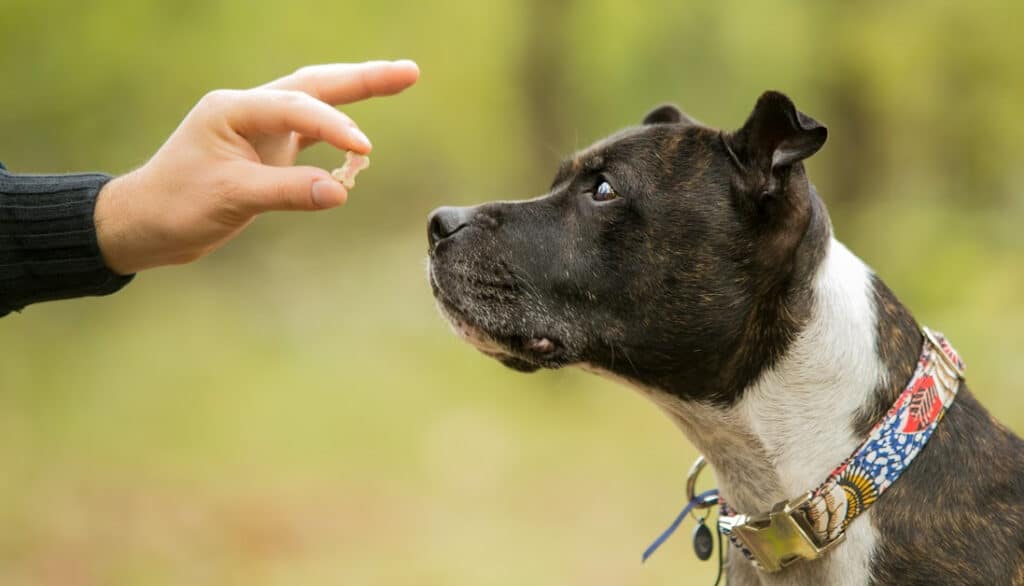
3. Herbsmith Microflora:
- What it is: Herbsmith Microflora is a probiotic supplement for dogs.
- Uses: Probiotics are beneficial bacteria that help restore and maintain a healthy balance in the digestive system. They can aid in managing and preventing gastrointestinal issues, especially after antibiotic treatments which can disrupt the gut’s natural flora.
- Advantages: Probiotics can boost the dog’s immune system, improve digestion, and reduce the likelihood of digestive issues.
4. Food Sensitivity Test Wellness Stress Scan:
- What it is: This is a diagnostic tool that tests for food sensitivities and environmental stressors in pets.
- Uses: By identifying specific sensitivities, owners can tailor their dog’s diet and environment to reduce potential triggers and related symptoms.
- Advantages: Addressing the root cause (like a specific food sensitivity) can sometimes reduce the need for medications, leading to a more holistic approach to the dog’s health.
Additional Complementary Natural Products to Tylosin:
It’s worth noting that, in addition to Tylosin alternatives, you can also add complementary natural products to the treatment plan to boost overall health.
- Herbs: Many herbs have antimicrobial and anti-inflammatory properties, like Echinacea and Goldenseal.
- Prebiotics: These are compounds that feed beneficial gut bacteria, promoting a healthy gut environment. Examples include inulin and fructooligosaccharides (FOS).
- Dietary Adjustments: Sometimes, a simple change in diet can alleviate gastrointestinal issues. This can involve switching to hypoallergenic foods or introducing foods known for their gut-soothing properties.
- Digestive Enzymes: These can aid in breaking down food more effectively, improving nutrient absorption and reducing digestive issues.
Dr. Candy’s recommendations emphasize a balanced approach to pet care, incorporating both traditional medications and natural remedies. While Tylosin is effective, considering alternatives and complementary treatments can provide a more comprehensive and holistic approach to a dog’s health. Always consult with a veterinarian before starting, stopping, or combining any treatments.
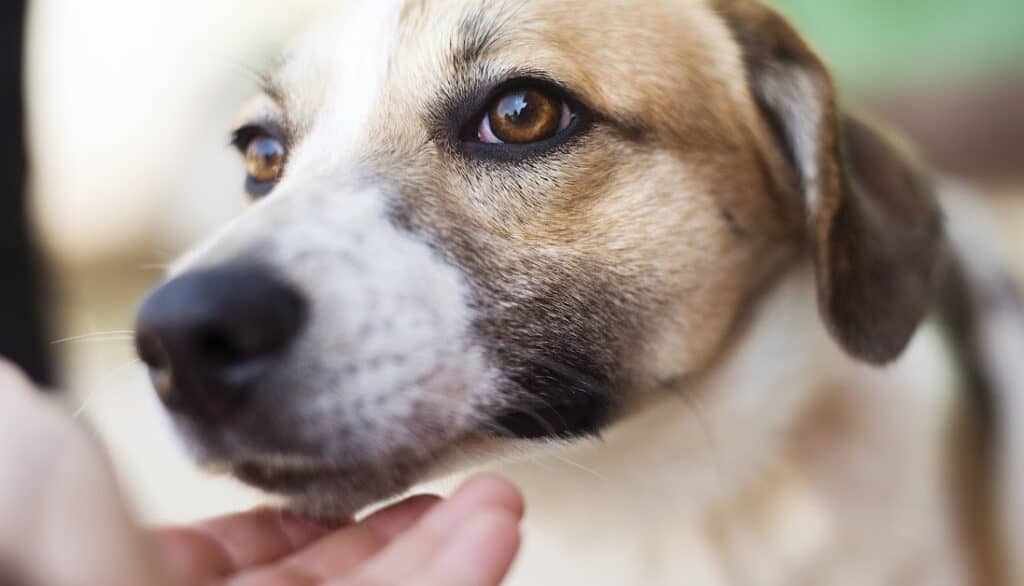
Complementary Natural Products to Tylosin That You Can Add To Your Treatment Plan
Incorporating natural products into your dog’s treatment regimen can provide a holistic approach to health and healing. These products, when used alongside conventional treatments, can complement and sometimes enhance their effects, ensuring a more rounded and effective treatment strategy. Here are some complementary natural products you can consider:
1. Omega-3 Fatty Acids:
- Benefits: Omega-3s, primarily found in fish oils, have anti-inflammatory properties. They can benefit dogs with skin allergies, joint issues, and certain inflammatory conditions.
- How to Administer: Available in liquid form or capsules, it can be added to your dog’s food.
2. Probiotics:
- Benefits: Probiotics help maintain a balanced gut flora, especially important after antibiotic treatments that can disrupt the natural balance of the digestive system.
- How to Administer: Typically available as powders or chews, they can be given as a daily supplement.
3. Digestive Enzymes:
- Benefits: Assist in breaking down food components, ensuring better nutrient absorption and reduced gastrointestinal issues.
- How to Administer: Generally in powder form, it can be sprinkled over your dog’s meal.
4. Turmeric (Curcumin):
- Benefits: Known for its potent anti-inflammatory and antioxidant properties, it can help with joint health, inflammation, and overall immune system support.
- How to Administer: Turmeric can be mixed with a bit of black pepper (which increases its absorption) and added to food. There are also commercial supplements available specifically for pets.

5. CBD Oil:
- Benefits: CBD has gained traction for its potential anti-inflammatory, pain-relieving, and calming effects. It can be helpful for dogs with anxiety, pain, or inflammation.
- How to Administer: CBD oil can be given directly or mixed with food. Ensure you’re using a dog-appropriate product and dose.
6. Milk Thistle:
- Benefits: Known for supporting liver health, it can be especially beneficial for dogs on medications that may impact the liver.
- How to Administer: Supplements are often available in capsule or liquid form.
7. Glucosamine and Chondroitin:
- Benefits: These compounds support joint health and can be beneficial for dogs with arthritis or joint issues.
- How to Administer: They are usually available in chewable tablet form or as liquids.
8. Herbs:
- Benefits: Many herbs like chamomile, ginger, and peppermint can have calming, anti-inflammatory, or digestive benefits for dogs.
- How to Administer: Depending on the herb, they can be offered as teas, added to food, or given as supplements.
Things to Remember:
- Consultation is Key: Always consult with your veterinarian before introducing any new product into your dog’s regimen. Natural doesn’t always mean safe, and some products can interfere with medications or have side effects of their own.
- Quality Matters: Opt for high-quality products from reputable brands. Ensure that they are suitable for pets and don’t contain harmful additives.
- Start Slow: When introducing a new natural product, start with a lower dose and monitor for any reactions or changes.
Incorporating natural products into your dog’s treatment plan can offer an array of health benefits, but always ensure that these are suitable for your dog’s specific needs and conditions. They should complement, not replace, prescribed treatments unless advised otherwise by a veterinarian.
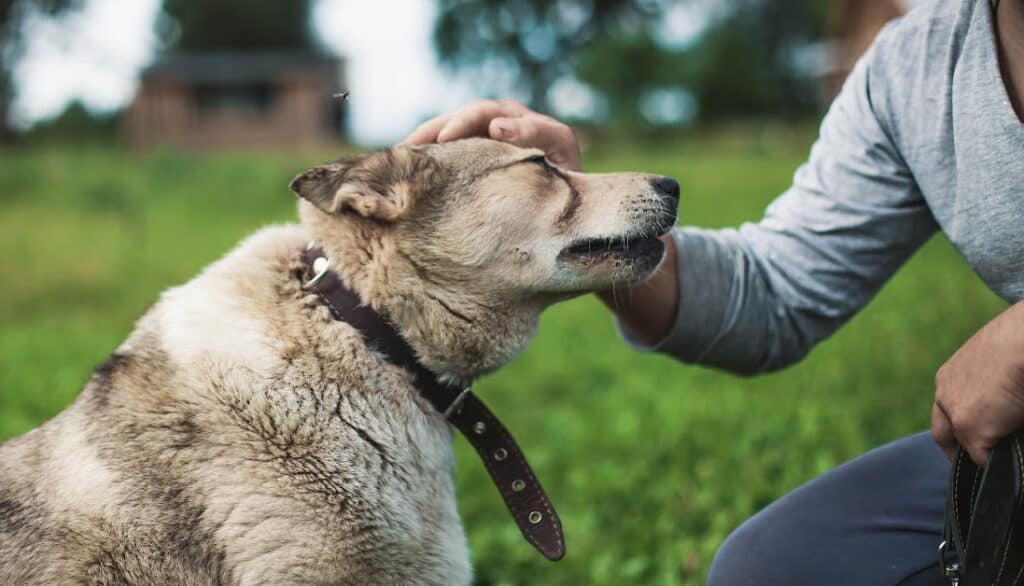
Conclusion
Caring for our furry friends often means diving deep into the realm of treatments, medications, and health regimens. Tylosin, as we’ve explored, is one of the tools in our arsenal to ensure the well-being of our pets. But like any medication, it’s vital to approach its use with knowledge and understanding. From recognizing its forms to gauging its appropriate dosage and exploring its alternatives, every piece of information equips us better to make informed decisions for our canine companions.
It’s heartening to know that in today’s world, we have the luxury of blending conventional medications with natural remedies, creating a comprehensive treatment plan that looks at health holistically. Dr. Candy’s insights and recommendations remind us of the importance of always seeking the best for our pets, be it through age-old herbs or cutting-edge medications.
Ultimately, as pet owners, our goal is the happiness and health of our four-legged family members. Whether you’re considering Tylosin or its alternatives, always remember that open communication with your veterinarian and staying informed are your best allies.
Thank you for journeying with us through this comprehensive look at Tylosin for dogs. We hope this guide serves you well and helps pave the way for many happy, tail-wagging days ahead! 🐾
Frequently Asked Questions
The FDA (U.S. Food & Drug Administration) has approved this drug for use in treating infections in dogs, cats, turkeys, chickens, cattle, pigs, and honeybees. The oral powder approved for turkeys, chickens, and pigs is most commonly used in companion animals (pets) to treat inflammatory bowel disease and in treating feline infectious peritonitis (FIP). You and your veterinarian can discuss why this drug is the most appropriate choice.
Many things might affect how well this drug will work in your animal. Be sure to discuss the following with your veterinarian so together you can make the best treatment decisions.
– Other drugs your animal is taking can interact with tylosin, so be sure to tell your veterinarian and pharmacist what medications (including vitamins, supplements, or herbal therapies) you give your animal, including the amount and time you give each.
– Tell your veterinarian about any conditions or diseases your animal may have now or has had in the past. If your animal has been treated for the same disease or condition in the past, tell your veterinarian about the treatment and how well it did or didn’t work.
– If your animal is pregnant or nursing, talk to your veterinarian about the risks of using this drug.
– Tell your veterinarian and pharmacist about any medication side effects (including allergic reactions, lack of appetite, diarrhea, itching, hair loss) your animal has developed in the past.
– This medication should start having effects within 1 to 2 hours; however, you may not see the effects of this medication outwardly.
– Your animal should begin feeling better within 1 to 2 days.
– The effects of this medication are short-lived, meaning they will stop working within 24 hours, although the benefits may be prolonged if your animal has decreased kidney and/or liver function.
No drug is 100% safe in all patients, but your veterinarian will discuss with you any specific concerns about using this drug in your animal.
This drug SHOULD NOT be used in:
– Animals allergic to it or drugs like it(eg, erythromycin, azithromycin).
– Horses or ponies.
This drug should be used WITH CAUTION in:
– Rabbits, guinea pigs, sheep, goats, deer, or other ruminants and select small mammals.
– Animals that are taking the medication digoxin.
If your animal has any of these conditions, talk to your veterinarian about the potential risks versus benefits.
Side effects that usually are not serious include:
– Loose stools, mild diarrhea, and stomach upset. You don’t have to be overly concerned if you see any of these signs unless they are severe, worsen, or continue to be a problem. Contact your veterinarian if this happens.
Side effects that may be serious or indicate a serious problem:
– Bloody diarrhea. Severe diarrhea that causes protrusion of the anus, especially in pigs. If you see any of these signs, contact your veterinarian immediately.
Tylosin is relatively safe in most overdose situations. If you witness or suspect an overdose, contact your veterinarian or an animal poison control center for further advice. Animal poison control centers that are open 24 hours a day include: Pet Poison HELPLINE (855-764-7661) and ASPCA Animal Poison Control Center (888-426-4435); a consultation fee is charged for these services.
For this medication to work, give it exactly as your veterinarian has prescribed. It’s a good idea to always check the prescription label to be sure you are giving the drug correctly.
– The drug may be given either with food or on an empty stomach. If your animal vomits or acts sick after receiving the drug on an empty stomach, try giving the next dose with food or a small treat. If vomiting continues, contact your veterinarian.
– Tylosin powder has an extremely bitter taste. Placing the dose of powder in an empty gelatin capsule or cold butter may help your animal take it better. Liquids made from mixing the powder in water should be thrown out after 3 days and a new solution made up.
– Liquid forms of this medication must be measured carefully. Your veterinarian or pharmacist can help by providing special measuring spoons or syringes.
– If you have difficulty getting your animal to take the medicine, contact your veterinarian or pharmacist for tips to help with dosing and reducing the stress of medication time.
– This medication can be given for various lengths of time. Be sure you understand how long your veterinarian wants you to continue giving this medication. Prescription refills may be necessary before the therapy will be complete. Before stopping this medication, talk to your veterinarian, as there may be important reasons to continue its use.
If you miss a dose, give it when you remember, but if it is close to the time for the next dose, skip the dose you missed and give it at the next scheduled time. After that, return to the regular dosing schedule. Do not double-up or give extra doses.
– Store this medication in the original prescription bottle or an approved dosage reminder container at room temperature and protected from light.
– Keep lids tightly closed on tylosin powder to protect from moisture. After mixing, the liquid solution should be thrown out after 3 days.
– If your veterinarian or pharmacist has made (compounded) a special formulation for your animal, follow the storage recommendations and expiration date for the product.
– Keep away from children and other animals.
There are no specific precautions required when handling this medication unless you are allergic to it. Wash your hands after handling any medication
– Do not flush this medication down the toilet or wash it down the sink.
– If a community drug “take-back” program is available, use this option. If there is no take-back program, mix the drug with coffee grounds or cat litter (to make it undesirable to children and animals and unrecognizable to people who might go through your trash), place the mixture in a sealable plastic bag to keep it from leaking out, and throw the bag out with the regular trash.
– Do not save leftover medication for future use or give it to others to use.
Use of this drug may not be allowed in certain animal competitions. Check rules and regulations before entering your animal in a competition while this medication is being administered.
